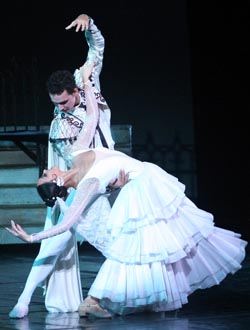In Anatolii Shekera’s Language
A festival dedicated to the great choreographer features Ukraine’s top-level ballet
The heart of this great choreographer stopped beating eight years ago. Numerous ballet lovers still remember the master, and his creative work is being continued by his students and followers.
Shekera’s stagings are always sold out. The four-day Shekera festival recently held in the National Opera was no exception — people were looking to buy spare tickets from others at the entrance. The program included magical and lyric Swan Lake, poetic and dramatic Romeo and Juliet, heroic Spartacus, and passionate and exquisite Bolero. These ballets showed the versatility of Shekera’s talent.
He was very careful with classical pieces and created his own ballet language at the same time. The audience takes turns at crying and laughing; it follows every scene with utmost attention and shares the emotions of the characters. Shekera had a gift of staging large-scale performances. Even so-called crowd scenes were never just a crowd of people on the stage — rather, they always played a special role defined for the dancers by the choreographer. Only the best dancers have solo parts in Shekera’s ballets. They demonstrate not only their virtuoso dancing technique, but also their dramatic skills, conveying the subtlest human feelings through the language of plastique and dancing. Perhaps this is why Shekera’s ballet performances have stood the test of time. They still stir the hearts of the viewers, and the artists compete for the honor of performing in Shekera’s ballets.
A few generations of dancers and choreographs who went through Shekera’s masterclass have evolved and matured. It is symbolic that his legendary Bolero and also some scenes and fragments of performances created by Shekera’s students and followers were performed at the gala concert, the closing ceremony of the festival.
Petro Chupryna, general manager of the National Opera of Ukraine says: “The phenomenon of this Ukrainian choreographer has to be studied and analyzed by theater experts and critics. His ballets brought fame to Ukraine and the Ukrainan school of choreography. He is in the same league with such masters as Marius Petipa, George Balanchine, Maurice Bejart, and Yury Grigorovich. Preserving classical traditions, Shekera concurrently searched and found his own expressive language of the dance. His efforts helped create a ballet group at the National Opera, which is rightfully considered to be the best one in Ukraine. For many years Shekera was chief ballet master of the Kyiv Opera and Ballet Theater. His ballets are featured by opera theaters not only in Ukraine, but also in many other countries, such as Croatia, Turkey, and Macedonia.”
Eleonora Stebliak, Shekera’s wife, was a great ballet dancer in the past and is a splendid teacher now. Thanks to her selfless devotion Shekera’s stagings still bring joy to ballet lovers. Many generations of artists polish their skills through participation in his performances. Maksym Motkov, the soloist of the National Opera, became the prize winner at the Shekera Ballet Festival this year. When he received the award, he said: “I am truly happy that I knew Anatolii Shekera in person and was fortunate to work with him. He had a gift of making all the dancers in the group excited about what they were doing, easily recognized a person’s talent, and was not afraid of experiments, asking young dancers to perform the most complicated dramatic parts.”
Viktor Yaremenko a former student of Shekera, now heads the National Opera’s ballet group. He says: “We uphold the traditions established by Anatolii Shekera.” Numerous stagings, which were produced by Shekera’s students and those who continue to create the modern ballet, were presented at the gala concert. Among those who demonstrated to the audience the results of their artistic search were Vadym Pysariev, Alla Rubina, Dmytro Kliavin, Viktor Lytvynov, Ondrej Soth, Aniko Rekhviashvili, Serhiy Bondur, and Viktor Yaremenko. The soiree was lit up by great dancers from Kyiv and Donetsk: Olena Filipieva, Serhiy Sydorsky, Maksym Motkov, Tetiana Liozova, Yuriy Kekalo, Hanna Dorosh, Maksym Chepik, Mykola Mikheyev, Hanna Filatova, Kostiantyn Pozharnytsky, Ihor Bulychov, Oleksandr Shapoval, Andriy Hura, and others.






